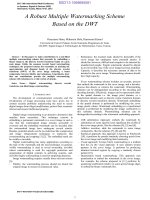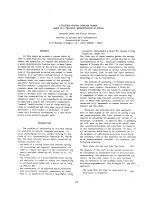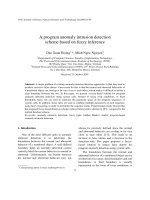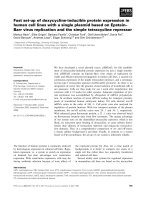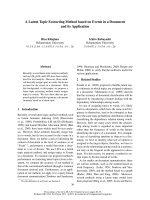A Precise Lane Detection Algorithm Based on Top View Image Transformation and LeastSquare Approaches
Bạn đang xem bản rút gọn của tài liệu. Xem và tải ngay bản đầy đủ của tài liệu tại đây (2.76 MB, 14 trang )
Hindawi Publishing Corporation
Journal of Sensors
Volume 2016, Article ID 4058093, 13 pages
/>
Research Article
A Precise Lane Detection Algorithm Based on Top View Image
Transformation and Least-Square Approaches
Byambaa Dorj and Deok Jin Lee
School of Mechanical and Automotive Engineering, Kunsan National University, Gunsan, Jeollabuk 573-701, Republic of Korea
Correspondence should be addressed to Deok Jin Lee;
Received 19 February 2015; Revised 21 June 2015; Accepted 23 June 2015
Academic Editor: Marco Listanti
Copyright © 2016 B. Dorj and D. J. Lee. This is an open access article distributed under the Creative Commons Attribution License,
which permits unrestricted use, distribution, and reproduction in any medium, provided the original work is properly cited.
The next promising key issue of the automobile development is a self-driving technique. One of the challenges for intelligent selfdriving includes a lane-detecting and lane-keeping capability for advanced driver assistance systems. This paper introduces an
efficient and lane detection method designed based on top view image transformation that converts an image from a front view to
a top view space. After the top view image transformation, a Hough transformation technique is integrated by using a parabolic
model of a curved lane in order to estimate a parametric model of the lane in the top view space. The parameters of the parabolic
model are estimated by utilizing a least-square approach. The experimental results show that the newly proposed lane detection
method with the top view transformation is very effective in estimating a sharp and curved lane leading to a precise self-driving
capability.
1. Introduction
In recent years, the researches regarding a self-driving capability for an advanced driver assistant systems (ADAS) have
received great attentions [1]. One of the key objectives of this
research area is to provide a more safe and intelligent function
to drivers by using electronic and information technologies.
Therein, the development of an advanced self-driving car
operating in hostile traffic environments becomes a very
interesting topic in these days. In hostile road conditions, a
recognition and detection capability of road signs, road lanes,
and traffic lights is very important and plays a critical role for
the ADAS systems [2, 3]. The lane detection technique is used
to control the self-driving car to keep its lane in a designated
direction, providing a driver with a more convenient and safe
assistant function [2, 3].
In general, the road lanes can be divided into two types
of trajectories, that is, a curved lane and a straight line [4].
In the literature, several methods were introduced for the
lane detection process as shown in Figure 1. However, most
of those methods usually detect only a straight lane by using
an original image obtained from a front view image. With
the straight lane detection, we can only recognize a near view
road range, but it makes it difficult to cognize a road turning
in a curved lane. In addition, when we use front view camera
images as original image source used in the detection process,
the detection of curved lanes is not trivial but becomes very
difficult leading to a poor detection performance.
In this paper, an effective lane detection algorithm is proposed with an improved curved lane detection performance
based on a top view image transform approach [5–7] and a
least-square estimation technique [8]. In the newly proposed
method, the top view image transformation technique converts the original road image into a different image space and
makes it effective and precise for the curved lane detection
process. First, a top view image converted from a front view
image is generated by using a top view image transform
technique. After the top view image transformation, the shape
of a lane becomes almost the same as the real road lane with a
minimum distortion. Then, the transformed image is divided
into two regions such as a near and a far section. In general,
the road shape in the near section can be modeled with
2
Journal of Sensors
Camera
image
Top view
image field
Figure 1: Top view image from a front view camera.
Front road image
Position of real
camera
Top view image
transform
Position of
virtual camera
Camera image
Divide two sections
Field of view
Far section
image
Near section
image
Figure 3: Schematic illustration of the top view image transformation.
Straight line detection
with Hough transform
Curved line detection
with parabolic model
Curved line detection
with least square
Combine two methods
Figure 2: The flow diagram of the lane detection algorithms using
the top view transformation and least-square based lane model
estimation.
a straight lane, while the shape of the road in the far section
uses either a straight line model or a curved lane model
[4, 9]. Therefore, in the near section, a straight line could
be transformed with a Hough transform method [10, 11],
and a parabolic model is used to find the correct shape of
the lane. On the other hand, in the far section, a curved
lane model is used with a high-order polynomial and the
parameters of the curved lane are estimated by using a leastsquare method. Finally, each near and far section model
are combined together, which leads to the construction of
a realistic road profile used in the ADAS systems. Figure 2
shows the flow process of the proposed top view based lane
detection algorithms in details.
The remainder of the paper is described as follows. In
Section 2, the principle of the top view transformation is
explained in detail. Section 3 illustrates the way of finding
the straight line profile in the near section with the Hough
transformation approach. In Section 4, a precise curved lane
detection algorithm in the far image section is designed
by using a parabolic lane detection approach where its
parameters are estimated with a least-square method. Finally,
in Section 5, realistic experiments are carried out in order to
verify the effectiveness and performance of the proposed new
method.
2. Top View Image Transformation
Top view image transformation is a very effective method as
an advanced image processing. Some researchers used the top
view transformation approach to detect obstacles and even
to measure distances to objects. An object’s shape on the
road is infracted in the top view transformed image where
a lane and a sign of the road are almost the same as the
real lane and sign (Figure 5). Therefore, the usage of the top
view image transformation becomes very effective for the lane
detection, leading to providing an advanced safe lane-keeping
and control capabilities.
Figure 3 shows the basic principle of the top view transformation where the real camera view is transformed into
Journal of Sensors
3
𝜃
𝛼
𝛾
H
Pi (Ui , Vi )
Pt (Xi , Yi )
L0
Li
𝜃h
Wmin
𝛽
Wi
Pt (Xi , Yi )
Figure 4: Top view image transformation.
(a)
(b)
Figure 5: (a) Road image. (b) TVI transformed image.
a virtual position with a direct top view angle. In order to
figure out the transformation relationship between the front
view image and the top view image, some key parameters
are required to be computed first. Figure 4 illustrates the
geometry of the top view transformed virtual image where
𝜃V is the vertical view angle, 𝜃ℎ is the horizontal view angle,
𝐻 is the height of camera located, and 𝛼 is the tilt angle of the
camera.
Figure 4 shows the geometry of top view transformed
image where 𝐻 is the height of camera located which is
measured in metric. It has to be converted into a pixel from
the metric, since the generated top view image is digital
image. Therefore, we need to find out the inversion coefficient
𝐾 which is used to transform the metric into the pixel data.
𝑉 is the width of the front view image 𝑃𝑖 (𝑈𝑖 , 𝑉𝑖 ) and is
proportional to 𝑊min of the top view image field illustrated
4
Journal of Sensors
0
y
𝜃
𝜌
𝜌 = y sin 𝜃 + x cos 𝜃
x
Figure 6: Hough transform.
in Figures 3 and 4, respectively. From this relation, the
coefficient, 𝐾, can be determined by using
𝐿 min = 𝐻 ∗ tan (𝛼) ,
𝑊min = 2 ∗ 𝐿 min ∗ tan (
𝐾=
𝜃ℎ
),
2
CameraImage (𝑈𝑖 , 𝑉𝑖 ) ⇒ TopViewImage (𝑥𝑖 , 𝑦𝑖 ) .
(1)
𝑉
.
𝑊min
Now, the height of the camera located in pixel data 𝐻pixel is
calculated by
𝐻pixel = 𝐻 ∗ 𝐾.
(2)
According to the geometrical description shown in Figure 4,
for each point 𝑃𝑖 (𝑈𝑖 , 𝑉𝑖 ) on the front view image, the corresponding sampling point 𝑃𝑡 (𝑋𝑖 , 𝑌𝑖 ) on the top view image can
be calculated by using the next equations of (3), (4), and (5)
as
𝛾 = 𝜃V ∗ (
𝑈 − 𝑈𝑖
),
𝑈
𝐿 𝑖 = 𝐻pixel ∗ tan (𝛼 + 𝛾) ,
(3)
𝐿 0 = 𝐻pixel ∗ tan (𝛼) ,
where 𝛾 is the dependent angle of the 𝑃𝑖 point of the 𝑈𝑖
position. The 𝑥𝑖 coordinate in the top view image is computed
by the following relation:
𝑥𝑖 = 𝐿 𝑖 − 𝐿 0 = 𝐻pixel ∗ tan (𝛼 + 𝛾) − 𝐻pixel ∗ tan (𝛼) .
(4)
Also, the 𝑦𝑖 coordinate is calculated by using the following:
𝛽 = 𝜃ℎ ∗ (
𝑉 − 𝑉𝑖
),
𝑉
𝑦𝑖 = 𝐿 𝑖 ∗ tan (𝜃ℎ − 𝛽) ,
where 𝛽 is the dependent angle of the 𝑃𝑖 point of the 𝑉𝑖
position. Then, color data is copied from the (𝑈𝑖 , 𝑉𝑖 ) position
of camera image to the (𝑥𝑖 , 𝑦𝑖 ) position of the top view image
by using the following relation:
(5)
(6)
Now, a more effective lane detection process could be carried
out more efficiently from the top view transformed image.
The top view transformed image could be divided into two
sections such as a near view section and a far view section.
In the near view section, a straight line model is used to
find a linear lane with a Hough transformation, while for
the far view section a parabolic model approach is adopted
for a curved lane detection in the top view image and its
parameters are estimated by utilizing a least-square approach.
3. Straight Line Detection with
Hough Transform
In the near view image, a straight line detection algorithm
is formulated by using a standard Hough transformation.
The Hough transform method searches for lines using the
equation as can be seen in Figure 6.
It is necessary to choose the longest straight line from the
lines detected from the Hough transformation. The applied
Hough transformation returns the coordinate of a starting
point (𝑥1 , 𝑦1 ) and the coordinate of the ending point (𝑥2 , 𝑦2 )
as can be seen in Figure 7.
Now, the equation of a straight line model equation is
defined and the parameters of the linear road model are
calculated by using the starting and ending coordinates from
each boundary condition of near section image. Equation (7)
shows the straight line model for the road linear detection as
follows:
𝑏=
(𝑦2 − 𝑦1 )
,
(𝑥2 − 𝑥1 )
(𝑦 − 𝑦1 )
𝑎 = 𝑦1 − 2
∗ 𝑥1 ,
(𝑥2 − 𝑥1 )
(7)
Journal of Sensors
5
y1 , x1
y2 , x2
(a)
(b)
Figure 7: (a) Binary image of top view. (b) Hough transform results.
0
y
Far
section
Boundary
line
Curved line
y = e ∗ x2 + d ∗ x + c
xm
Near
section
Straight line
y= b∗x+a
Hough
transform
x
Figure 8: Road Line models for the near section and the far section.
where 𝑏 is the slope of the linear detection model. It is noted
that the parameters, 𝑎 and 𝑏, used in the liner line detection
model are also used again in a curved line detection process
in the far view image space.
+
)=
𝑓 (𝑥𝑚
4. Curved Line Detection
4.1. Curved Line Detection Based on Parabolic Model. In the
far view image, a curved line detection is necessary, and the
previous parameters of the straight line model are used again.
Since a curved line is modeled as a continuous one starting
right after the straight line, it has a common boundary
condition (𝑥𝑚 , 𝑦𝑚 ) as can be seen in Figure 8.
On the same boundary points, the functional value of the
straight line equation is equal to the value of the parabolic
+
−
) = 𝑓(𝑥𝑚
) where 𝑓(𝑥) is a
curved line equation as 𝑓(𝑥𝑚
parabolic model used for the curved line detection as follows:
{𝑏 ∗ 𝑥 + 𝑎,
𝑓 (𝑥) = {
𝑒 ∗ 𝑥2 + 𝑑 ∗ 𝑥 + 𝑐,
{
The differential value of 𝑓(𝑥) function is also equal to the
+
−
) = 𝑓 (𝑥𝑚
), and the differential
boundary point as 𝑓 (𝑥𝑚
values are calculated by
if 𝑥 > 𝑥𝑚
if 𝑥 ≤ 𝑥𝑚 .
(8)
𝑓
−
(𝑥𝑚
)
=
𝜕 (𝑏 ∗ 𝑥 + 𝑎)
= 𝑏,
𝜕𝑥
𝜕 (𝑒 ∗ 𝑥2 + 𝑑 ∗ 𝑥 + 𝑐)
𝜕𝑥
(9)
= 2𝑒 ∗ 𝑥 + 𝑑.
These conditions imply also the following relations:
2
+ 𝑑 ∗ 𝑥𝑚 + 𝑐,
𝑏 ∗ 𝑥𝑚 + 𝑎 = 𝑒 ∗ 𝑥𝑚
𝑏 = 2𝑒 ∗ 𝑥𝑚 + 𝑑.
(10)
Note that 𝑎 and 𝑏 parameters are already obtained from the
Hough transformation in the previous section. Now, it is
necessary to compute the 𝑐, 𝑑, and 𝑒 parameters for the curved
6
Journal of Sensors
20
19
17
15
16
18
20
14
12
10
8
9
11
13
7
5
3
1
2
4
6
xm , ym
xm , ym
xi , yi
xm , ym
xm , ym
Figure 10: Sequence of finding white points.
Figure 9: White points of far section.
parabolic model. From (10), 𝑐 and 𝑒 parameters are computed
by:
𝑐 = 𝑎+
𝑥𝑚
(𝑏 − 𝑑) ,
2
1
𝑒=
(𝑏 − 𝑑) .
2𝑥𝑚
(11)
Each 𝑥𝑖 , 𝑦𝑖 coordinate has a specific relation with the 𝑑𝑖
value, and (13) shows this relationship. Based on the relation,
our main equation 𝑑𝑖 is formulated with (14). Finally, the
value of the parameter, 𝑑, is computed by using all the 𝑑𝑖
values
𝑦𝑖 = 𝑎 + 𝑥𝑚
𝑑𝑖 =
Substituting these values back into (8) leads to the following
relations:
𝑓 (𝑥)
𝑏 ∗ 𝑥 + 𝑎,
if 𝑥 > 𝑥𝑚 (12)
{
{
={ 1
𝑥
{
(𝑏 − 𝑑) ∗ 𝑥2 + 𝑑 ∗ 𝑥 + 𝑎 + 𝑚 (𝑏 − 𝑑) , if 𝑥 ≤ 𝑥𝑚 .
2
{ 2𝑥𝑚
Note that now only 𝑑 parameter is undefined and it is
necessary to be resolved. Therefore, in order to find out the
parameter value 𝑑, first it is required to find all the white
points from the boundary point 𝑥𝑚 , 𝑦𝑚 , in the curved line
section as can be seen in Figure 9.
Then, the coordinates of all the white points are used to
define parameter 𝑑. Figure 10 shows the sequence of finding
the white points.
(𝑏 − 𝑑𝑖 )
(𝑏 − 𝑑𝑖 ) 2
𝑥,
+ 𝑑𝑖 𝑥𝑖 +
2
2𝑥𝑚 𝑖
2
(2𝑥𝑚 𝑦𝑖 − 2𝑎𝑥𝑚 − 𝑏𝑥𝑚
− 𝑏𝑥𝑖2 )
1 𝑛
𝑑 = ∑𝑑𝑖 .
𝑛 𝑖=1
2 −𝑥)
(2𝑥𝑖 − 𝑥𝑚
𝑖
(13)
,
(14)
The effectiveness of the proposed parabolic model approach
using the curved line detection approach is shown in
Figure 11. As can be seen, the boundary of the curved
line and the linear line perfectly matched. However, the
parameterized curved model computed in the far view
section is not perfectly aligned with the original curved line.
This is because the parameters used in the parabolic model
have some bias and errors. In order to compensate for the
misalignment of the curved line in the far image section,
an effective estimation technique is utilized in the next
section.
4.2. Curved Line Detection Based on Least-Square Method. In
the previous section, the parameters in the parabolic model
are computed by using the white points in the curved line
Journal of Sensors
7
Figure 11: Result of curve lane detection based on parabolic model.
Figure 12: Result of curve lane detection based on least-square
method.
section. In this section, in order to increase the accuracy of
the computation of the parameters of the curved line, an
effective least-square estimation technique which uses all the
given data {(𝑥1 , 𝑦1 ), . . . , (𝑥𝑛 , 𝑦𝑛 )} is integrated. First, the leastsquare method is formulated by using the data as follows;
is matched with the original white line, but the boundary
points of the linear line are not aligned well. Thus, it is
needed to match the boundary conditions in the least-square
method.
𝑛
𝑛
𝑛
𝑛
∑𝑥𝑖 ∑𝑥𝑖2
∑𝑦𝑖
𝑖=1
𝑖=1
𝑖=1
𝑐
𝑛
𝑛
)
)
( 𝑛
(𝑛
( ∑𝑥𝑖 ∑𝑥𝑖2 ∑𝑥𝑖3 ) (𝑑) = ( ∑𝑦𝑖 𝑥𝑖 ) .
)
)
(
(
𝑖=1
𝑖=1
𝑖=1
𝑖=1
𝑛
𝑛
𝑛
𝑛
𝑒
∑𝑥𝑖2 ∑𝑥𝑖3 ∑𝑥𝑖4
∑𝑦𝑖 𝑥𝑖2
𝑖=1
𝑖=1 )
)
(𝑖=1
(𝑖=1
(15)
Equation (15) forms the linear matrix equation with the
matrix, 𝑀, as follows:
𝑛
𝑛
𝑛
𝑖=1
𝑛
𝑖=1
𝑛
𝑖=1
𝑛
𝑖=1
𝑛
∑𝑥𝑖 ∑𝑥𝑖2
)
( 𝑛
( ∑𝑥𝑖 ∑𝑥𝑖2 ∑𝑥𝑖3 ) = 𝑀.
)
(
𝑖=1
𝑛
𝑐=
(16)
𝑑=
∑𝑥𝑖2 ∑𝑥𝑖3 ∑𝑥𝑖4
𝑖=1
𝑖=1 )
(𝑖=1
Since all the data {𝑥𝑖 , 𝑖 = 1, 2, . . . , 𝑛} is given, the 𝑀 matrix
is calculated easily. Then, after the computation of the matrix,
the 𝑐, 𝑑, and 𝑒 parameters of the curved parabolic line model
are calculated by
𝑛
𝑐
∑𝑦𝑖
𝑖=1
)
(𝑛
)
(𝑑) = inv (𝑀) (
( ∑𝑦𝑖 𝑥𝑖 ) .
𝑖=1
𝑛
𝑒
∑𝑦𝑖 𝑥𝑖2
)
(𝑖=1
4.3. Integration of Parabolic Model and Least-Square Method.
It is noted that each method of the parabolic approach
and the least-square method has its own advantages and
disadvantages in the curved line detection step. The previous
ideas obtained in the curved line detection lead us to invent
a new curved line detection methodology by integrating two
methods as for an effective and precise curved line detection
technique. For a new curved line detection technique, the
parabolic detection approach and the least-square methods
are integrated together by calculating the parameters used in
the curved line model as
(17)
Figure 12 shows the curved line detection result by using the
least-square method. It is shown that the detected curved line
𝑒=
(𝑐parabolic + 𝑐least )
2
,
(𝑑parabolic + 𝑑least )
2
(𝑒parabolic + 𝑒least )
2
,
(18)
.
As can be seen in (18), the parameters obtained in each
detection method are computed again by averaging the
parameter values, which resulted in more precise curved line
detection performance as can be seen in Figure 13 where
the green line is the result from the integrated method. The
integrated method not only aligned with the original white
line but also matched the same boundary conditions of the
linear line model.
5. Experiment Results
In this section, realistic road experiments are carried out. In
the experiments, 10 images, which contain straight line and
8
Journal of Sensors
Figure 13: Curved line detection results: integrated curved line detection (green).
Figure 14: Road image.
Figure 15: Top view transformed image.
curved line, are used. Example results are shown in Figure 14
to Figure 24. In addition, for the performance check, error
plots are investigated in Figures 20, 21, and 28 measured in
a pixel unit.
5.1. Experiment Results Number 1. See Figures 14–21.
5.2. Experiment Results Number 2. See Figures 22–29.
The newly proposed detection algorithm requires 0.5–
2 sec for the one-time detection; the required computational
time depends on the adopted image size, tilt angle, and
height of camera. 80% of this process time is due to the
usage of the top view image transformation. If either a
Journal of Sensors
9
y1 , x1
y2 , x2
(a)
(b)
Figure 16: (a) Binary image of top view. (b) Hough transform results.
Figure 17: Result of curve lane detection based on parabolic model.
Figure 18: Result of curve lane detection based on least-square method.
10
Journal of Sensors
Error of Y coordinate
Figure 19: Curved line detection results: integrated curved line detection (green).
Error of line 1
10
5
0
−5
−10
0
20
40
60
80
100 120
Number of pixels
140
160
180
Error of Y coordinate
Figure 20: Error graphic of first line.
Error of line 2
10
5
0
−5
0
20
40
60
80
100
120
140
160
Number of pixels
Figure 21: Error graphic of second line.
Figure 22: Road image.
GPU or a FPGA processor is utilized for top view image
transformation, the expected processing time for the line
detection could be reduced more. In the near future work,
we will use GPU and FPGA processor for the top view
transformation.
The most important advantage of the newly proposed
curved line detection algorithm lies in the fact that the parameter values used in the line detection could be computed
precisely, which result in a more robust ADAS performance.
In specific, if the parameter value of 𝑑 is higher than zero, it
Journal of Sensors
11
Figure 23: Top view transformed image.
(a)
(b)
Figure 24: (a) Binary image of top view. (b) Hough transform results.
Figure 25: Result of curve lane detection based on parabolic model.
12
Journal of Sensors
Figure 26: Result of curve lane detection based on least-square method.
Error of Y coordinate
Figure 27: Curved line detection results: integrated curved line detection (green).
20
10
0
−10
−20
−30
−40
Error of line 1
0
100
200
300
400
500
600
700
800
Number of pixels
Figure 28: Error graphic of experiment number 2.
d>0
d<0
d≈0
Figure 29: Relation of 𝑑 parameter and road turning.
900
Journal of Sensors
indicates that the road is turning left. If the 𝑑 parameter value
is lower than zero, it indicates that the road is turning right,
and if 𝑑 parameter value is around zero, it means that the road
is straight. As can be seen, the test results indicate that the new
algorithm makes its application to the self-driving car more
effective.
6. Conclusion
In this paper, an effective lane detection method is proposed
by using the top view image transformation approach. In
order to detect a precise line of the entire lane in the
transformed image, the top view image is divided into two
sections, near image and far image. In the near image
section, a straight line detection is performed by using
the Hough transformation, while, in the far image section,
an effective curved line detection method is proposed by
integrating an analytic parabolic model approach and the
least-square estimation method in order to precisely compute
the parameters used in the curved line model. For the
verification of the newly proposed hybrid detection method,
experiments are carried out. From the results it is shown
that a curved line shape of the white lines after the top view
image transformation almost perfectly matches the real road’s
white lines. The effectiveness of the proposed integrated lane
detection method can be applied to not only the self-driving
car systems but also the advanced driver assistant systems in
smart car systems.
Conflict of Interests
The authors declare that there is no conflict of interests
regarding the publication of this paper.
Acknowledgments
This work was supported by the National Research Foundation of Korea (NRF) (no. 2014-063396) and also was
supported by the Human Resource Training Program for
Regional Innovation and Creativity through the Ministry of
Education and National Research Foundation of Korea (no.
2014-066733).
References
[1] A. A. M. Assidiq, O. O. Khalifa, M. R. Islam, and S. Khan, “Real
time lane detection for autonomous vehicles,” in Proceedings of
the International Conference on Computer and Communication
Engineering (ICCCE ’08), pp. 82–88, Kuala Lumpur, Malaysia,
May 2008.
[2] S. Sehestedt and S. Kodagoda, “Efficient lane detection and
tracking in urban environments,” in Proceedings of the 3rd
European Conference on Mobile Robots (ECMR ’07), Freiburg,
Germany, September 2007.
[3] C. Qiu, “An edge detection method of lane lines based on
mathematical morphology and MATLAB,” in Proceedings of the
Cross Strait Quad-Regional Radio Science and Wireless Technology Conference (CSQRWC ’11), vol. 2, pp. 1266–1269, Harbin,
China, July 2011.
13
[4] C. R. Jung and C. R. Kelber, “A lane departure warning system
based on a linear-parabolic lane model,” in Proceedings of the
IEEE Intelligent Vehicles Symposium, pp. 891–895, University of
Parma, Parma, Italy, June 2004.
[5] H. Kano, K. Asari, Y. Ishii, and H. Hongo, “Precise top view
image generation without global metric information,” IEICE
Transactions on Information and Systems, vol. 91, no. 7, pp. 1893–
1898, 2008.
[6] Q. Lin, H. Hahn, and Y. Han, “Top-view-based guidance for
blind people using directional ellipse model,” International
Journal of Advanced Robotic Systems, vol. 10, 2013.
[7] T. Wu and A. Ranganathan, “A practical system for road
marking detection and recognition,” in Proceedings of the IEEE
Intelligent Vehicles Symposium, pp. 25–30, Alcala de Henares,
Spain, June 2012.
[8] I. Markovsky, J. C. Willems, S. van Huffel, and B. De Moor, Exact
and Approximate Modeling of Linear Systems: A Behavioral
Approach, 1st edition, 2006.
[9] M. Revilloud, D. Gruyer, and E. Pollard, “An improved approach
for robust road marking detection and tracking applied to
multi-lane estimation,” in Proceedings of the IEEE Intelligent
Vehicles Symposium, pp. 783–790, June 2013.
[10] T. Ganokratanaa, M. Ketcham, and S. Sathienpong, “Real-time
lane detection for driving system using image processing based
on edge detection and Hough transform,” in Proceedings of
the International Conference on Digital Information and Communication Technology and Its Applications (DICTAP ’13), July
2013.
[11] C.-C. Tseng and H.-Y. Cheng, “A lane detection algorithm
using geometry information and modified Hough transform,”
in Proceedings of the 18th IPPR Conference on Computer Vision
Graphics and Image Processing, pp. 796–802, August 2005.
International Journal of
Rotating
Machinery
Engineering
Journal of
Hindawi Publishing Corporation
Volume 2014
The Scientific
World Journal
Hindawi Publishing Corporation
Volume 2014
International Journal of
Distributed
Sensor Networks
Journal of
Sensors
Hindawi Publishing Corporation
Volume 2014
Hindawi Publishing Corporation
Volume 2014
Hindawi Publishing Corporation
Volume 2014
Journal of
Control Science
and Engineering
Advances in
Civil Engineering
Hindawi Publishing Corporation
Hindawi Publishing Corporation
Volume 2014
Volume 2014
Submit your manuscripts at
Journal of
Journal of
Electrical and Computer
Engineering
Robotics
Hindawi Publishing Corporation
Hindawi Publishing Corporation
Volume 2014
Volume 2014
VLSI Design
Advances in
OptoElectronics
International Journal of
Navigation and
Observation
Hindawi Publishing Corporation
Volume 2014
Hindawi Publishing Corporation
Hindawi Publishing Corporation
Chemical Engineering
Hindawi Publishing Corporation
Volume 2014
Volume 2014
Active and Passive
Electronic Components
Antennas and
Propagation
Hindawi Publishing Corporation
Aerospace
Engineering
Hindawi Publishing Corporation
Volume 2014
Hindawi Publishing Corporation
Volume 2014
Volume 2014
International Journal of
International Journal of
International Journal of
Modelling &
Simulation
in Engineering
Volume 2014
Hindawi Publishing Corporation
Volume 2014
Shock and Vibration
Hindawi Publishing Corporation
Volume 2014
Advances in
Acoustics and Vibration
Hindawi Publishing Corporation
Volume 2014
